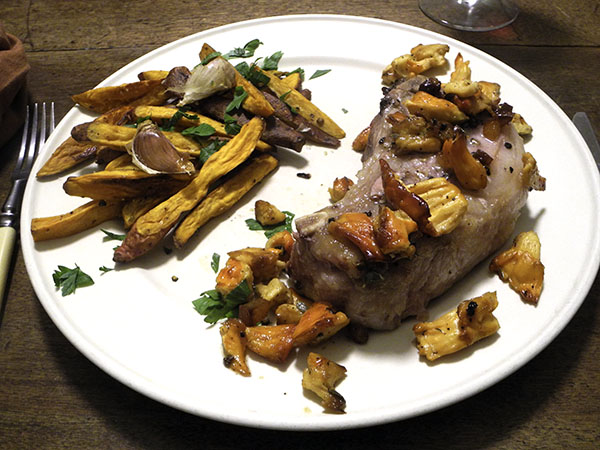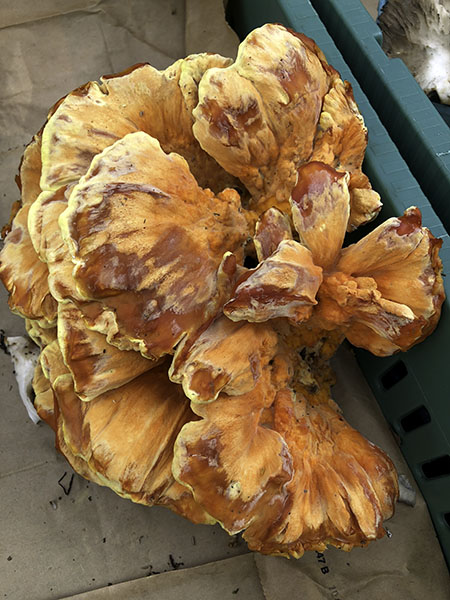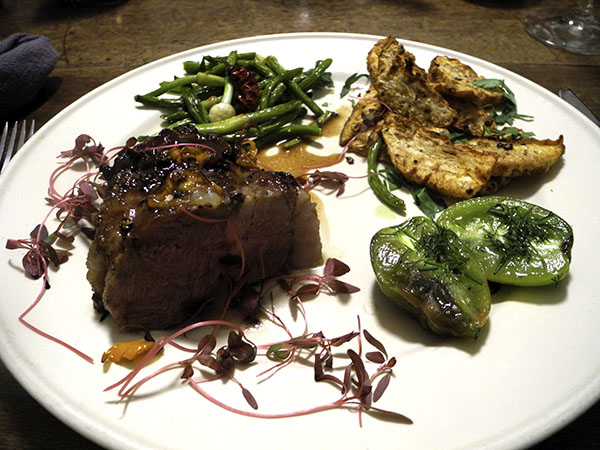
I thought this meal was pretty special all the way around.
There were certainly at least a couple exotic elements, but everything was quite local.
I had been really looking forward to preparing these very special chops. They turned out to be even more delicious than I had expected, which is saying a lot, after having very much enjoyed this pork in other forms.

I used the same basic recipe I almost always use, but this time I had something else new to me to try out, a part of a gorgeous locally foraged chicken of the woods [laetiporus sulphureus] mushroom, and I incorporated it in the lemon sauce which is always produced naturally by the chops.

The vegetable was a bit less exotic, but it too was local, and from a local greenmarket, that at Union Square. I didn’t catch their name, but they were very neat sweet potatoes. The choice, and the orange hue, anticipated colder autumn weather and the meals it inspires, but it didn’t add another color to the plate; for that I had to add some chopped parsley.
- two 8-ounce Mangalitsa pork chops from Møsefond Farm [more here], purchased at Chelsea’s Down to Earth Farmers Market, located only one block west of us, defrosted inside the refrigerator overnight and brought to room temperature the next evening, thoroughly dried, seasoned with sea salt and freshly ground black pepper, seared quickly inside a heavy enameled cast-iron oval pan before half of an organic Whole Foods Market lemon was squeezed over the top and then left in the pan between the chops, placed inside a 425º oven for between 14 and 16 minutes altogether (flipped halfway through, the lemon squeezed over them once again and replaced in the pan), removed from the oven, arranged on warm plates and topped with a combination of the juices that remained in the pan and a sauce produced by sautéing small pieces torn from a larger section of a locally-foraged chicken of the woods mushroom (laetiporus sulphureus) from Windfall Farms in the Union Square Greenmarket only moments before inside a medium high-sided heavy antique copper pot in a mix of a little olive oil and a ¼”-diced piece of Buon Italia guanciale that had been browned in the oil, the fat of the bit of cured pork cheek having been slowly rendered in the oil, after which a few tablespoons of a good white wine and 4 small sprigs of fresh thyme from Keith’s Farm, tied together, were added to the sauce pot with the mushroom, the liquid reduced a little over a higher flame before the thyme was removed
- five sweet potatoes, or just under a pound, from Central Valley Farm, left unpeeled, but washed thoroughly, cut as for short french fries, tossed inside a bowl with olive oil, sea salt, freshly-ground black pepper, two large unpeeled cloves of rocambole garlic from Keith’s Farm, and a pinch of crushed dark dried habanada pepper, roasted in a 425º oven in a treasured large well-seasoned Pampered Chef unglazed ceramic oven pan for about 35 minutes, or until crispy on the outside, soft on the inside, and a little chewy on the edges, some Maldon salt thrown onto the pan after it was removed from the oven, the frites arranged on the plates and garnished with chopped parsley from Phillips Farms
- the wine was an excellent California (Sonoma) red, Jacqueline Bahue Sonoma Valley Cabernet Franc 2016, from Naked Wines
- the music was at least our second listening of Antonio Vivaldi’s very silly, but absolutely beautiful 1731 opera, ‘La Fida Ninfa’



